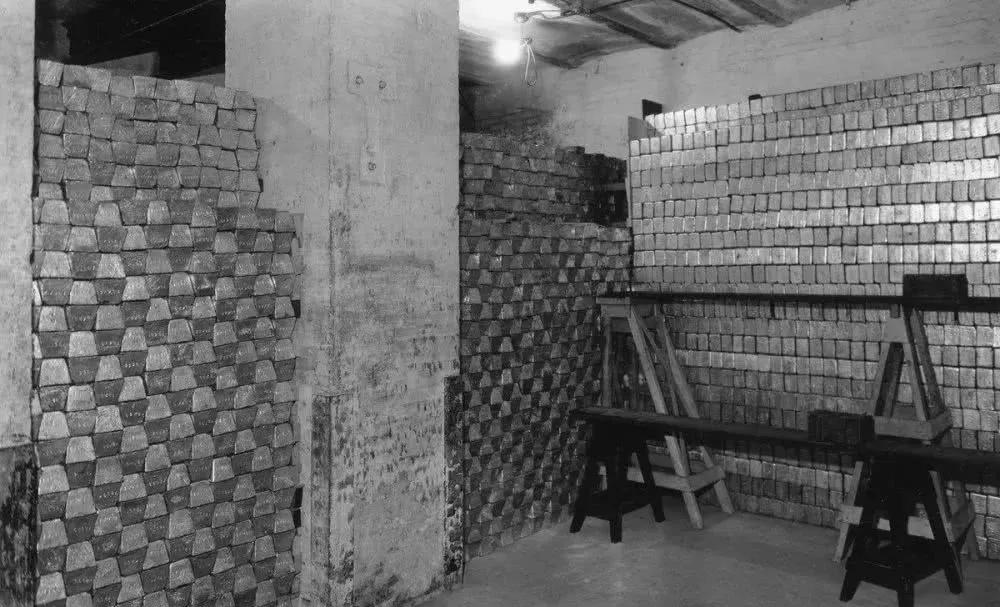In the summer of 1970, Rogelio Roxas, a 27-year-old Filipino locksmith, was so busy that he led 10 workers to dig in Baguio City, north of the capital, Manila.
He was a locksmith and a crazy treasure hunter.
About a few years ago, he got a valuable message from a Japanese veteran stranded in the Philippines:
The whereabouts of the treasure under the mountain.

Pictured: Gold stored by the Japanese army in World War II
Yamashita Treasure is one of the most famous lost treasures in the world.
During World War II, the Japanese army plundered astronomical amounts of gold and jewelry across Southeast Asia and hoarded them in the Philippines.
On the eve of Japan's defeat, japanese commander Yamashita buried the gold in batches in various parts of the Philippines, and it is said that in order to ensure secrecy, after burial, the entrance to the tunnel was blown up and covered, and the soldiers who worked inside were buried alive.
Pictured: Yamashita Bongwen and his treasure
After the surrender of Japan, Yamashita was hanged by the Allies as a war criminal, and some of the gold was captured by the Americans, but most of it was buried deep in the soil.
In the Philippines, although many people know about the "treasure under the mountain", no lucky one can find it.
Pictured: Yamashita during the post-war trial
The Japanese veteran had witnessed the process of burying the treasure by the Japanese army and drew the location of a tunnel.
As soon as Roxas found the treasure, he immediately organized people and horses to start digging on the land near Baguio General Hospital, 24 hours a day.
However, the locksmith was not digging, but with the permission of the local judge.
According to Philippine law, half of the treasures dug up underground belong to me.
After about seven months of excavation, in January 1971, a tunnel system was excavated.
Wires, radios, bayonets, rifles, and a skeleton dressed in Japanese uniform were found, and it appears that the rumors are true.
After several weeks of excavation, after a 10-foot-thick concrete wall at the bottom of the tunnel, the workers found a golden Buddha statue about three feet tall and weighing about 1 ton.
Pictured: Roxas and his Golden Buddha
In addition to the Golden Buddha, Roxas also found a large number of neatly arranged boxes under the wall, and he opened one of them, which contained 24 gold bars.
Roxas, who had successfully searched for treasure, was so excited that he blocked the tunnel entrance and returned home with a golden Buddha, 24 gold bars, and some Japanese samurai swords, planning to sell the golden Buddha first, and then use the money sold to continue digging the remaining treasure.
After the buyer came to the door to identify, it was believed that the golden Buddha was made of at least 22 carats of pure gold.
Roxas also discovered that the head of the Golden Buddha was mobile, and that it contained many uncut diamonds.
After the successful treasure hunt, Rojas did one thing, he asked the photographer to come to the door to take a photo of himself with the Golden Buddha.
Why the high profile?
It's not that he's not smart, it's a self-preservation act of public information. But he still underestimated the dangers of the world.
Pictured: Roxas and golden Buddha
In the early hours of April 5, 1971, Philippine dictator President Marcos sent a group of armed soldiers to break into Roxas's home and beat him and his family, taking away the golden Buddha and 17 gold bars (Roxas sold another 7).
Roxas was subsequently arrested and imprisoned, and soldiers tortured him until 1974, when soldiers tortured him to confess the details of the treasure.
For the next twelve years, the locksmith kept a low profile.
In February 1986, Marcos was forced into exile in Hawaii, U.S., after massive protests caused by electoral fraud.
Only then did Roxas go to court against the former president for instructing militants to loot his treasure.
A few years later, Roxas, who did not wait for the verdict, died of depression at the age of 49.
Pictured: The descendants of the locksmith received only a replica of the bronze Buddha
In 1996, a jury in a Hawaiian court handed down the verdict:
Marcos was ruled for stealing a golden Buddha statue and 17 gold bars, awarding $22 billion in damages, the largest sum ever.
However, due to the complexity of the case, the descendants of the locksmith have not yet received compensation.
Photo: Yamashita Treasure is still hidden deep in the Philippines
Some "Yamashita Treasure" researchers believe that the vast majority of the wealth of "Yamashita Treasure" is still hidden in the Philippines, scattered in 172 places, and as many as 18 golden Buddhas alone.
So who is the next lucky or unlucky locksmith?